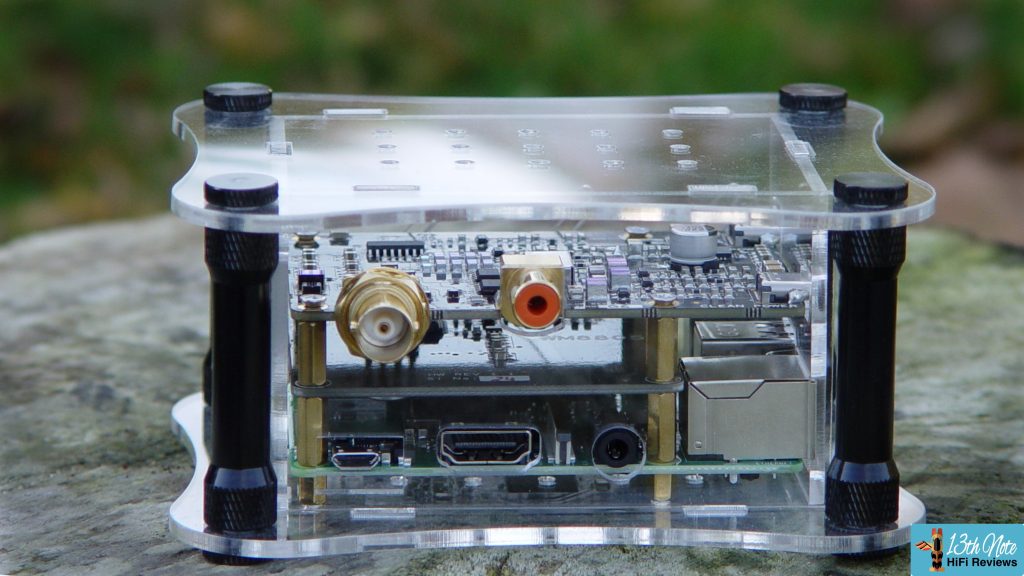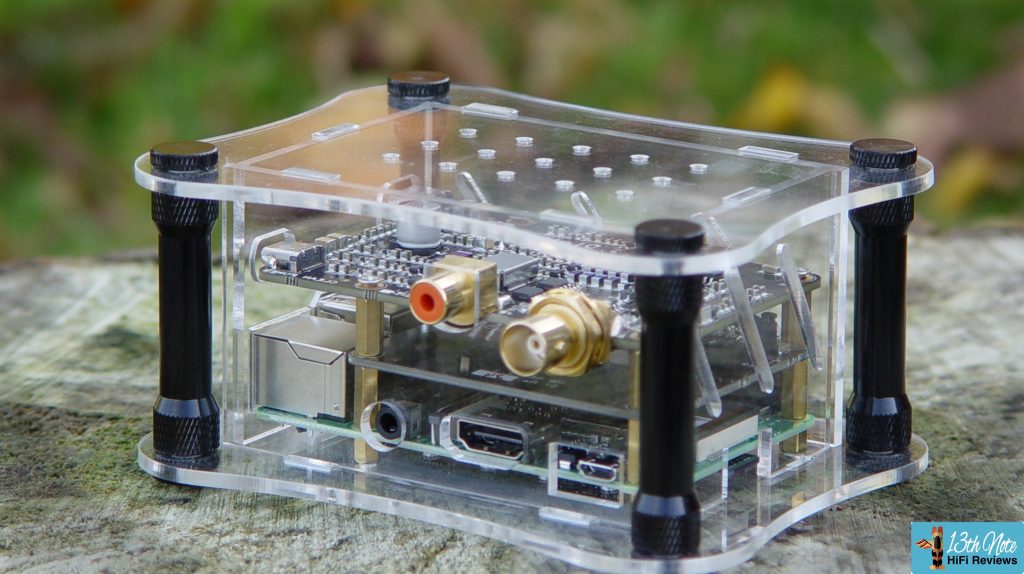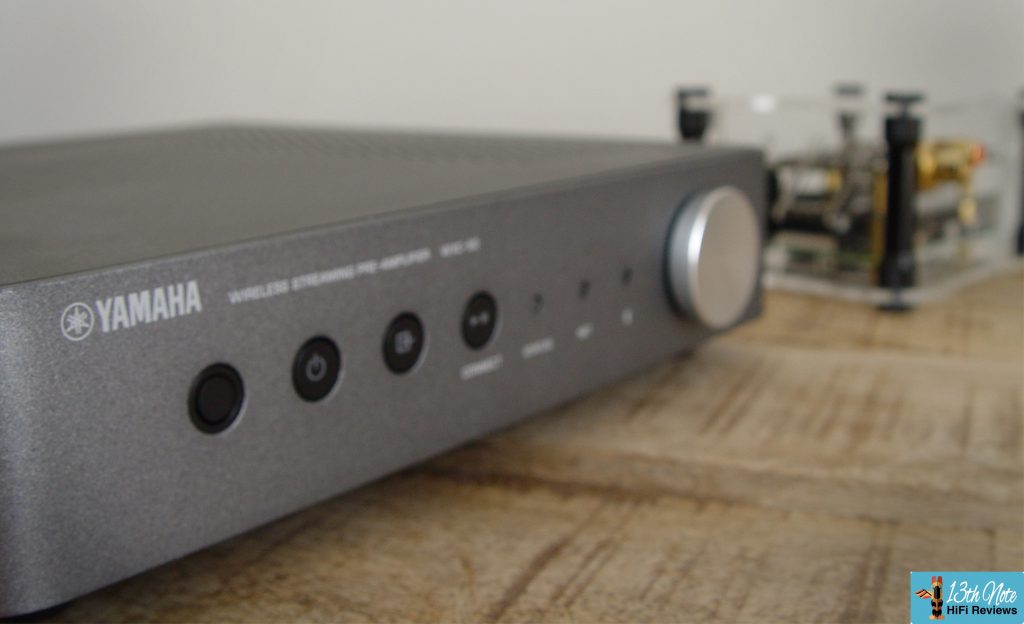The idea behind the quirky looking Allo DigiOne Signature streamer is this; take a Raspberry Pi mini computer which can be had for tens of dollars, pimp it, and challenge conventional streamers?
To do this pimping it uses two extra boards mounted on top of the bottom layer Pi, in a kind of sandwich. Already this language could have an entirely different connotation on a different part of the internet… Anyway, normally a Pi can be configured with a micro USB input for power and Ethernet input to get internet for music streaming services, and a USB output to your DAC. Its operating system comes not so much on a ‘wafer thin mint’ SD card type, but in miniature micro SD card guise. Choose the operating system you want and off you pop.
But like me you probably won’t be doing all of this, as set up is a little bit geeky and messy and audio lovers and techie computing don’t mix. Right? Well not if you want an off the shelf streamer, something to work out of the box?
The problem with the Pi alone is that it’s electrically noisy, not in a kind of buzzing energy substation kind of way, but being designed for computer and not audio use. So the two additional boards go the extra mile – the middle one takes the digital music signal from the Pi and converts it into a standard that allows conventional means of output to a DAC ; in the form of the cable type that is coaxial digital. The conventional most common means of sending digital to a DAC. I²S to S/PDIF for the geeks.

The top board is called the clean board as it is electrically isolated and clean from the Pi and middle ‘HAT’ boards. All three boards are connected up by riser pins which allow signal and power to pass between the respective boards. But unlike many delegated governments, power passes downwards from the top because USB-C power sockets are on this top board.
Because one of these power sockets is to ‘juice up’ the top clean board and the other is to send power downwards, obviously but unusually you need two power supplies. You can use conventional wall-wart power supplies – a plug with lead basically, or cleaner linear power supply types, having a more stable supply. You could use a battery type, but would you put up with the faff of remembering to change or charge them as they run down for what are often slight sonic improvements. I know I probably wouldn’t.
The Allo Shanti dual linear power supply is its partner; A quick look at the manual tells you which power socket is needed to connect to which of the two USB-C sockets. Be careful and no accidents please, because of different current requirements for each. Also connect them up in the right order!
So before you can dance around your living room to Disco Inferno by The Trammps, you’ve got an Ethernet lead to your router on the lower Pi board and two power leads to the top board. Also you use either of the two coaxial digital outputs from the top board to your DAC (or DAC containing component of course)- coaxial BNC, or coaxial RCA.

You want the Allo DigiOne Signature with different music systems. No problem. Allo recommended me one called Volumio, a free open source music player managed through a web interface. This comes preconfigured on the micro SD card which Allo do for you before you buy.
I hit upon using it as a Roon end point streamer as Pi’s can be used as such. As long as your Roon server is on the network the Roon app recognises it as ‘Volumio’ under Settings>Audio.
The techie bit maybe?
Normally I don’t write articles like an instruction manual, but in this case I’ll do so (a bit) to hopefully leave techiness at the door of men with huge glasses and beards and who wear t-shirts with audiophile written on it. I’ll kindly exclude you if you fit into one of these stereotypes by the way! 😀
Type in http://volumio.local in your PC or laptops web browser. Connect up to WiFi, do the spandangled thing of entering passwords and your are ready to add network music containing drives. NAS for Network Attached Storage, not ‘No Actual Sense’ by the way.
Don’t try and add an NAS drive in Volumio as a ‘network share’ if your NAS’ internal media server is found under the lower media servers icon. It means avoiding entering in loads of password and network share permutations and checking router and protection settings. Aarrrrgghhh! I might never have lost those 3 hours of my life I’ll never get back, if I had swiped down a bit in the app.

You can also buy the Volumio app cheaply from the Apple or Android stores. Even at £1.99 a begrudging purchase, given how so many apps are free nowadays. However, you need to do the jiggery-pockery with the web browser first before the Volumio app is ready to shake your hand.
You want to use your Spotify, Qobuz or Tidal subscription – well you have to upgrade to ‘MyVolumio Virtuoso’ by paying a subscription. The face off was to ask me for €28.99 or over instalments. No thank you for review purposes but there are means and ways to integrate services like Tidal into Volumio for free eg AudFree. If you want to use a USB stick with music, you can by plugging it into one of the Pi boards USB slots. Naturally there is free internet radio functionality via Volumio.
Once I got Volumio working it was acceptably decent to use. Not anywhere near Roon standards, but Volumio was temperamental finding my NAS. Whether the fact I use my NAS on an extender or inherent issues in Volumio (a free piece of software after all), I’m not so sure. Others I chatted to on Facebook had no such issues.
Where is it placed?
Streamers like the Bluesound Node 2i or departing Sonos Connect (replaced by the Sonos Port) have been the revered standard at these prices. Remember going into dealers ten years ago to see Sonos Connect’s on about every system that produced sound waves. Alas the early days of streaming. I’ve tried the original Node 2 and owned the Connect myself.

Similarly, Yamaha’s WXC-50 streaming pre amp is typical of the type of budget streamers out there for around £300/$350. At $315 for the DigiOne Signature and $160 for the Shanti, not a million miles away from the price of the Yamaha, and none at all if you use standard wall-warts.
So first to using the WXC-50 streamer with a Chord Qutest DAC and JDS Labs Atom headphone amp, paired with HIFIMAN HE1000 version 2 headphones. Well yuck…and isolated to be all the Yamaha’s fault and not the other components, coming from a reference dCS Bartók with the HIFIMAN HE1000 v2’s. God damn compromised HiFi components built to a budget and to be all things to all men like the Yamaha. Well actually not if you take these comments sarcastically. Maybe describing ‘Yuckiness’ is a stretch in a comparative connoisseur like way and analysing minutiae, but then it’s all relative of course.
But with the Allo DigiOne Signature, what is coming across is just smoothness, good levels of detail and refinement. A very easy listen. Also good Treble is taken aback somewhat but levels of realism are punching above what a $315 streamer should achieve. It’s like tipping a shot of smooth creamey tasting Irish Bushmills whiskey into a coffee with cream.
Maybe bass is too easy at times, since bass notes are conjoined – not in an unpleasant way but bass dynamics is loose and you feel the thickness in bass. I suspect this is the sonic acoustic affects of the Shanti, so I was keen to try with switching power supplies…
Since I only had one such ‘switcher’ available I first used it on the clean connection, anticipating poorer results; a USB-C to USB cable into a computer female USB 5v @ 1.3amp wall-wart. The veil on treble is lifted, dynamics is better and everything has nicer neutrality and more depth into the music. Surprising….

I didn’t have a 5v 3amp switching power supply easily to hand, to use on the ‘dirty’ Pi power socket, so I used my only available Sandstrom 5v 3amp phone charger type battery and used the Shanti’s output to the clean board. This was better still with all the qualities as before but an opened up soundstage, which is a quality you notice as you swap to nosier streamers. Easily the best of the three set ups. A good switching wall supply to the dirty board would probably be more than adequate. These tests go to show, linear power supplies are not always a necessity, albeit often revved up as being *better*. That said they do often have a role in overly analytical systems but the Chord Qutest and HE1000 v2’s are quite neutral so no need to smooth them out.
The feeling initially is that the Yamaha WXC-50 is actually pretty close to the Allo DigiOne Signature. Good bass response, nice detail and dynamics. A test between the DigiOne Signature connected solely with the Shanti and the Yamaha, might to some impress the Yamaha as being *better* on account of unsmoothed credentials.
Not so however. Listen more and you can pick out the Yamaha having a open hazy unpleasantness in the upper midrange and treble which, after a while, makes listening more grating. It’s not a brightness but a kind of spaceyness that you can’t help feeling needs filling with some tone. It’s one of those qualities in music that you don’t quite know what it is, but it will be making you reach to remove the headphones or turn your HiFi off, without knowing why.
Switch back to the Allo DigiOne Signature again and it’s obvious you are getting a much better bargain for your money, so too when I compare it to a much cheaper Chromecast Audio streamer, which has much more overt haziness.

I also used the DigiOne Signature into various HiFi system configurations (see system below). You could tell the noise floor is a bit higher than the dCS Bartók and bass not as accurate and tight but surprisingly, closer than you would think with diametrically competing HiFi. The same was true of the other system.
What this tells you is that the Allo DigiOne Signature can very much challenge conventional streamers. It’s a no brainer against noisy HiFi like the Yamaha, which to be fair is built to a price and performance. So long as the DAC is good, this test proves yet again that streamers themselves can achieve tremendous audio for modest money, making an argument of ‘Why spend more?’ I would not be surprised if it outcompetes sub $1000 streamers like the Node 2 or Connect, in side by side tests.
So if you want a leftfield idea, in a quirky looking product, and to get maximum performance instead of conventional streamers, it’s definitely Allo Allo with the DigiOne Signature. Just make sure you use the correct power supply combination. Very recommended and it achieves the 13th Note for the money!
Manufacturer
Website : www.allo.com
Email : sales@allo.com

Specifications – Allo DigiOne Signature
- Bit depth / sample rate ; up to 24/192
- Jitter : less than 400fs
- Galvanically isolated between Pi board and others
- Power : 2 X USB-C (5v/2-3amps to PI board and 5-6v/100mA)
- Digital Output : 1 x BNC/Coaxial, 1 x RCA/Coaxial
- Ethernet output
- Choice of playback systems : Volumio, DietPI, Moode, Max2Play
- Micro SD Card : 16GB (standard)
- Case : Clear Acrylic / Black Acrylic
Price
- DigiOne Signature – $315
- Shanti Linear PSU (option) – $149
- Options on the website for SD card / Battery supplies / Switch mode power supplies ($11)
Test Systems
Headphone : HIFIMAN HE1000 v2, Chord Qutest DAC, Yamaha WXC-50 Streamer, JDS Labs Atom headphone amp.
HiFi : 1) dCS Bartók with Cyrus Mono X200 signature power amps, PMC twenty5 23 speakers, IsoTek Aquarius power conditioner, 2) Cyrus DAC XP Signature pre amp with partnering PSX-R power supply, Chord Qutest DAC, PMC twenty5 23 Speakers, IsoTek Aquarius.







